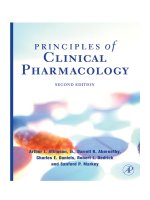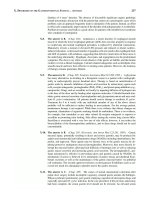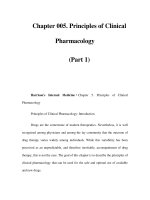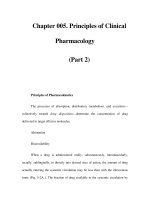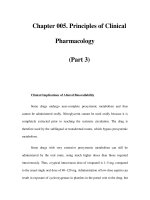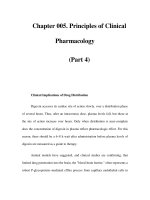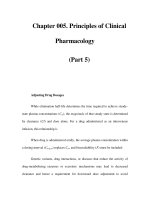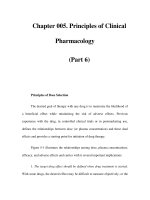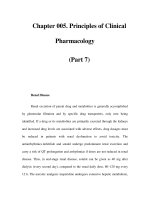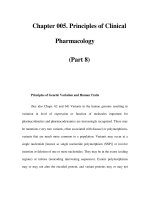Chapter 005. Principles of Clinical Pharmacology (Part 7) pptx
Bạn đang xem bản rút gọn của tài liệu. Xem và tải ngay bản đầy đủ của tài liệu tại đây (13.43 KB, 5 trang )
Chapter 005. Principles of Clinical
Pharmacology
(Part 7)
Renal Disease
Renal excretion of parent drug and metabolites is generally accomplished
by glomerular filtration and by specific drug transporters, only now being
identified. If a drug or its metabolites are primarily excreted through the kidneys
and increased drug levels are associated with adverse effects, drug dosages must
be reduced in patients with renal dysfunction to avoid toxicity. The
antiarrhythmics dofetilide and sotalol undergo predominant renal excretion and
carry a risk of QT prolongation and arrhythmias if doses are not reduced in renal
disease. Thus, in end-stage renal disease, sotalol can be given as 40 mg after
dialysis (every second day), compared to the usual daily dose, 80–120 mg every
12 h. The narcotic analgesic meperidine undergoes extensive hepatic metabolism,
so that renal failure has little effect on its plasma concentration. However, its
metabolite, normeperidine, does undergo renal excretion, accumulates in renal
failure, and probably accounts for the signs of central nervous system excitation,
such as irritability, twitching, and seizures, that appear when multiple doses of
meperidine are administered to patients with renal disease. Protein binding of
some drugs (e.g., phenytoin) may be altered in uremia, so measuring free drug
concentration may be desirable.
In non-end-stage renal disease, changes in renal drug clearance are
generally proportional to those in creatinine clearance, which may be measured
directly or estimated from the serum creatinine (Chap. 272). This estimate,
coupled with the knowledge of how much drug is normally excreted renally vs
nonrenally, allows an estimate of the dose adjustment required. In practice, most
decisions involving dosing adjustment in patients with renal failure use published
recommended adjustments in dosage or dosing interval based on the severity of
renal dysfunction indicated by creatinine clearance. Any such modification of dose
is a first approximation and should be followed by plasma concentration data (if
available) and clinical observation to further optimize therapy for the individual
patient.
Liver Disease
In contrast to the predictable decline in renal clearance of drugs in renal
insufficiency, the effects of diseases like hepatitis or cirrhosis on drug disposition
range from impaired to increased drug clearance, in an unpredictable fashion.
Standard tests of liver function are not useful in adjusting doses. First-pass
metabolism may decrease—and thus oral bioavailability increases—as a
consequence of disrupted hepatocyte function, altered liver architecture, and
portacaval shunts. The oral availability for high-first-pass drugs such as morphine,
meperidine, midazolam, and nifedipine is almost doubled in patients with
cirrhosis, compared to those with normal liver function. Therefore the size of the
oral dose of such drugs should be reduced in this setting.
Heart Failure and Shock
Under conditions of decreased tissue perfusion, the cardiac output is
redistributed to preserve blood flow to the heart and brain at the expense of other
tissues (Chap. 227). As a result, drugs may be distributed into a smaller volume of
distribution, higher drug concentrations will be present in the plasma, and the
tissues that are best perfused (the brain and heart) will be exposed to these higher
concentrations. If either the brain or heart is sensitive to the drug, an alteration in
response will occur. As well, decreased perfusion of the kidney and liver may
impair drug clearance. Thus, in severe congestive heart failure, in hemorrhagic
shock, and in cardiogenic shock, response to usual drug doses may be excessive,
and dosage reduction may be necessary. For example, the clearance of lidocaine is
reduced by about 50% in heart failure, and therapeutic plasma levels are achieved
at infusion rates of 50% or less than those usually required. The volume of
distribution of lidocaine is also reduced, so loading regimens should be reduced.
Drug Use in the Elderly
In the elderly, multiple pathologies and medications used to treat them
result in more drug interactions and adverse effects. Aging also results in changes
in organ function, especially of the organs involved in drug disposition. Initial
doses should be less than the usual adult dosage and should be increased slowly.
The number of medications, and about 2 h; this is because the dose raises the
concentration of drug in plasma many times higher than the threshold for its
pharmacologic effect.
Even in the absence of kidney disease, renal clearance may be reduced by
35–50% in elderly patients. Dosage adjustments are therefore necessary for drugs
that are eliminated mainly by the kidneys. Because muscle mass and therefore
creatinine production are reduced in older individuals, a normal serum creatinine
concentration can be present even though creatinine clearance is impaired; dosages
should be adjusted on the basis of creatinine clearance, as discussed above. Aging
also results in a decrease in the size of, and blood flow to, the liver and possibly in
the activity of hepatic drug-metabolizing enzymes; accordingly, the hepatic
clearance of some drugs is impaired in the elderly. As with liver disease, these
changes are not readily predicted.
Elderly patients may display altered drug sensitivity. Examples include
increased analgesic effects of opioids, increased sedation from benzodiazepines
and other CNS depressants, and increased risk of bleeding while receiving
anticoagulant therapy, even when clotting parameters are well controlled.
Exaggerated responses to cardiovascular drugs are also common because of the
impaired responsiveness of normal homeostatic mechanisms. Conversely, the
elderly display decreased sensitivity to -adrenergic receptor blockers.
Adverse drug reactions are especially common in the elderly because of
altered pharmacokinetics and pharmacodynamics, the frequent use of multidrug
regimens, and concomitant disease. For example, use of long half-life
benzodiazepines is linked to the occurrence of hip fractures in elderly patients,
perhaps reflecting both a risk of falls from these drugs (due to increased sedation)
and the increased incidence of osteoporosis in elderly patients. In population
surveys of the noninstitutionalized elderly, as many as 10% had at least one
adverse drug reaction in the previous year.
Genetic Determinants of the Response to Drugs
